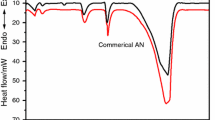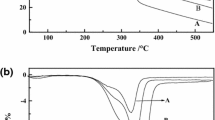Abstract
The influence of some polyvalent cations on the thermostability of cellulose was investigated using both conventional TG analysis and quasi-isothermal treatment at elevated temperatures. It was established that ions of copper, cobalt and iron absorbed in the cellulose fibre surface accelerated the thermal decomposition of cellulose chain molecules, the temperature of the main decomposition decreasing very significantly. Lewis acid type additives (such as ZnCl2) promote the hydrolytic decomposition and hence the temperature of the post-decomposition increases compared with that of the blank sample. Ions of alkaline earth metals (Ca and Ba) do not affect the thermal behaviour of cellulose fibres. From the results of the quasi-isothermal experiments the apparent energy of activation for the decomposition of cellulose in the presence of metal ions was calculated.
Résumé
L'influence de plusieurs cations polyvalents sur la stabilité thermique de la cellulose a été étudiée par TG conventionnelle et traitement quasi-isotherme à températures élevées. On a établi que les ions cuivre, cobalt et fer adsorbés à la surface de la fibre de cellulose accélèrent la décomposition thermique des molécules de la chaine de cellulose et que la température de la décomposition principale diminue de manière très appréciable. Les additifs du type acides de Lewis (comme ZnCl2) facilitent la décomposition hydrolytique et c'est pourquoi la température de la décomposition ultérieure augmente, comparée à celle du témoin. Les ions alcalino-terreux (Ca et Ba) n'exercent pas d'action sur le comportement thermique des fibres de cellulose. A partir des données obtenues par les examens quasi-isothermes on a calculé l'énergie d'activation apparente de la décomposition de la cellulose en présence d'ions métalliques.
Zusammenfassung
Der Einfluß einiger mehrwertigen Kationen auf die Temperaturbeständigkeit von Zellstoffen wurde unter Anwendung der konventionellen Thermogravimetrie und der quasi-isothermen Behandlung bei höheren Temperaturen, untersucht. Es wurde festgestellt, daß an der Oberfläche der Zellstoff-Faser adsorbierte Kupfer-, Eisen- und KobaltIonen die thermische Zersetzung der Kettenmoleküle des Zellstoffes beschleunigen, wodurch die Temperatur des Hauptvorganges wesentlich herabgesetzt wird. Zusätze vom Typ der Lewis-Säuren(z.B. ZnCl2) begünstigen die hydrolytische Zersetzung, wodurch die Temperatur nach der Zersetzung im Vergleich mit der Blindprobe ansteigt. Die ionender Erdalkalimetalle (Ca und Ba) haben keine Wirkung auf das Verhalten von Zellstoff-Fasern. Aus den Ergebnissen der quasi-isothermen Behandlung wurde die scheinbare Aktivierungsenergie der Zellstoffzersetzung in Anwesenheit von Metallionen berechnet.
Резюме
С помощью обычного ТГ анализа и квазиизотермическо й обработки при повыш енных температурах исслед овано влияние некото рых многовалентных кати онов на термоустойчивость ц еллюлозы. Установлен о, что адсорбированные на п оверхности целлюлоз ного волокна ионы меди, коб альта и железа ускоря ют термическое разложе ние цепных молекул целлю лозы и при этом темпер атура главного процесса ра зложения значительн о понижается. Добавка л ьюисовских кислот (на пример, ZnCl2) ускоряет гидролитич еское разложение, вследств ии чего температура п оследующего разложения увеличив ается по сравнению с образц ом сравнения. Ионы щелочно-земельных ме таллов (Ca и Ba) не оказывают влияния на термическое повед ение целлюлозных волокон. На основании данных квазиизотерм ических измерений вы числена кажущаяся энергия ак тивации реакции разложения целлюлоз ы в присутзтвии ионов металлов.
Similar content being viewed by others

References
G. A. Petropavlovszkij andG. H. Mihajlov, Cell. Chem. and Techn., 6 (1972) 213.
B. Philipp, J. Baudisch andH. Ruscher, TAPPI, 82 (1969) 693.
C. D. Kay, Forest Prod. J., 18 (1969) 71.
M. Kosik, V. Reiser andI. Michlik, Papir a Celuloza, 28 (1973) 29.
J. Györe andS. Faragó, Magyar Kém. Folyóirat, 81 (1975) 36.
N. Hurduc, I. A. Schneider andCr. Simionescu, Cell. Chem. and Techn., 2 (1968) 569
O. P. Golova andR. G. Krilova, Dokl. AN SSSR, 116 (1957) 419.
O. P. Golova, Uspk. Khim., 44 (1975) 1454.
W. K. Jany andW. K. Neill, J. Pol. Sci., C6 (1964) 65.
D. M. MacDonald, TAPPI, 48 (1965) 708.
S. Hernádi, Papíripar, 14 (1970) 8.
J. H. E. Herbst, TAPPI, 45 (1962) 833.
T. P. Cziepel, TAPPI, 43 (1960) 289.
W. H. Langwell, TAPPI, 38 (1955) 190A.
O. A. Battista, Ind. and Eng. Chem., 42 (1950) 502.
A. Hernàdi, Svensk Papperstidn., 79 (1976) 418.
Author information
Authors and Affiliations
Rights and permissions
About this article
Cite this article
Hernádi, S. The influence of polyvalent cations on the thermostability of cellulose. Journal of Thermal Analysis 21, 67–76 (1981). https://doi.org/10.1007/BF01913701
Received:
Issue Date:
DOI: https://doi.org/10.1007/BF01913701



